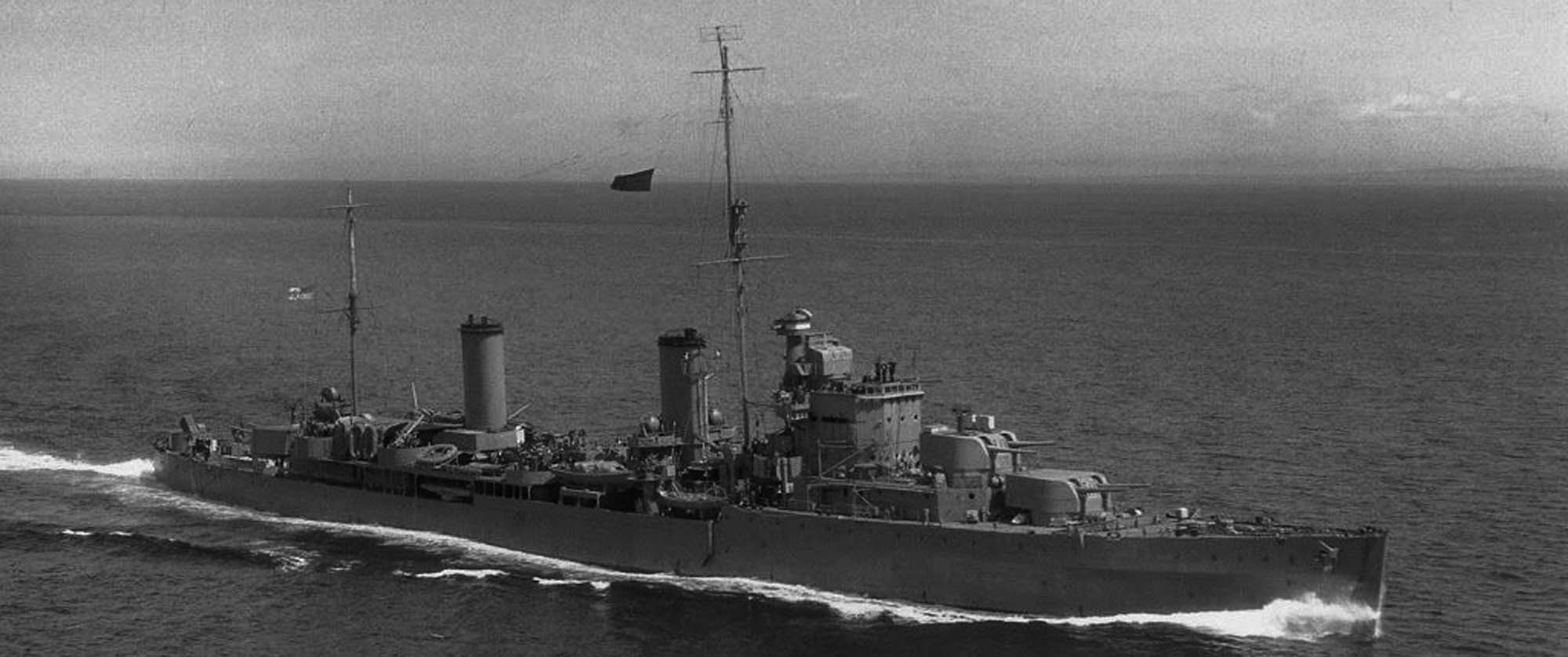
The new generation British light cruisers
The Arethusa class was the second class of light cruiser built after the end of the Great War. Built on a budget, they fitted within the confines of the Washington Treaty, deriving from Amphion group of the Leander class to save additional money. Of the six ships planned initially, 1919 crisis obliged, only four were completed. Tonnage was used for other ships of a completely redesigned configuration. These famous light cruisers, of which two were lost in action, were among the most decorated and battle-hardened in the Royal Navy.
Design
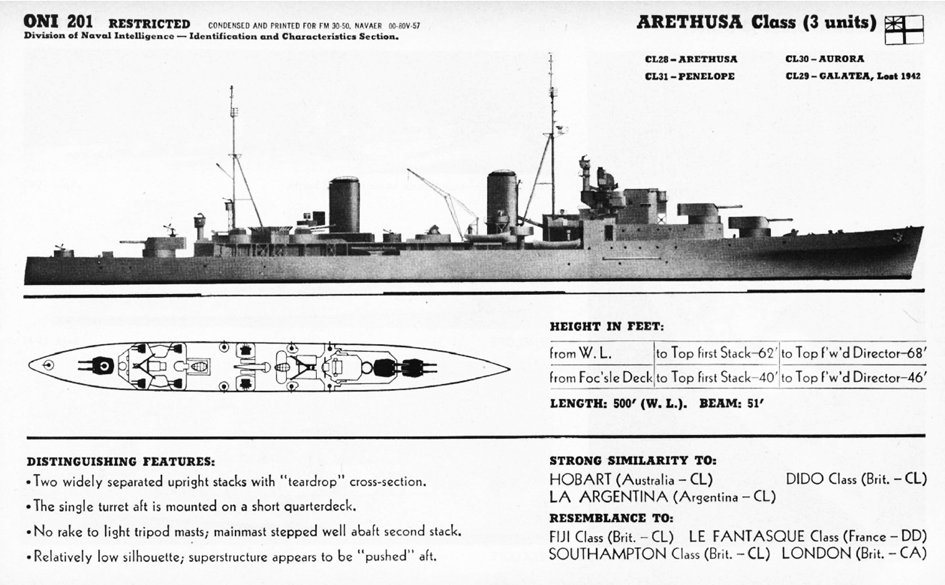
The Admiralty, pressured by the parliament, needed to save money (as for the York class) and by deleting a turret, down to six 6-in instead of eight, think the overall cost would be reduced.
The lenght in reduction indeed also saved tonnage, allowing to build an additional cruiser. The new light cruiser class was designed to operate against enemy cruisers and protect trade routes. Artillery was considered sufficient in this role but emphasis was on speed, to the detriment of protection which barely rose do 70 mm.
The design overall was judged to be the minimum required for a “trade route cruiser” to counter the threat of the auxiliary cruiser over which, even with their reduced armament, they would enjoy a comfortable superiority. They were also to be capable of acting as a fleet cruiser (which was fortunate because, in the end, they were used almost exclusively with the fleet).
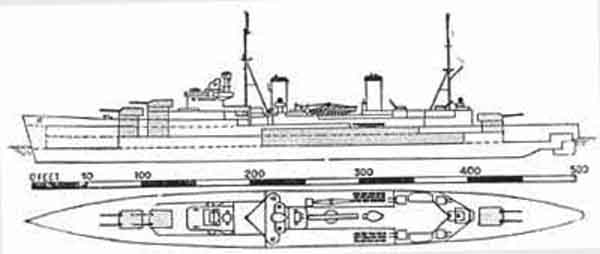
Therefore, no reduction in speed (i.e. machinery) could be accepted, and savings had to be found in armament, size and protection. The Arethusa sacrificed their ‘X’ 6-inch aft gun turret and this measure saved a 50 feet (15 m) section of hull, displacement dropping by 1,250 tons compared to the the Leanders. Protection scheme was the same as the Leanders but generally thinner to save additional weight. This allowed six Arethusas to be built for the price of five Leanders within the constraints of tonnage allowed under treaties in force (Washington and London). Welded construction was widely used for the first time to save weight, and this alone saved an additional 250 tons, were cut off from the original specification. The final ships were even lighter thn plannes, which was exceptionally rare.
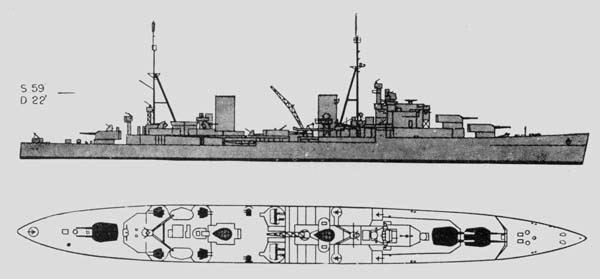
The final class would consist of HMS Arethusa, Galatea, Penelope and Aurora, the first accepted in service in May 1935 and the last in November 1937. They were all in the thick of the action in the Mediterranean, but they saw action in many other theaters as well, Galatea and Penelope paying the ultimate price in operations as we will see.
Armament
Main armament
They were armed with six BL 6 inch Mark XXIII in three twin mountings Mark XXI in ‘A’, ‘B’ and ‘Y’ positions. The modern BL 6-inch Mk XXIII naval gun were introduced in 1931 and served on all British Cruisers until the Minotaur class. They used hand-operated Welin breech blocks, and 14 kgs cordite bags of flashless (NQFP) powder. The shells weighted 51 kg (112-pound) HE or AP, with the muzzle velocity of 2760 feet per second (840 m/s) for the AP. Max range was 25,480 yd (23,300 m) at 45 degrees elevation. Loading could be done up to +12.5 degrees.
Secondary armament
The secondary armament was four QF 4-inch Mark V on single mountings HA Mark III, controlled by a HACS director on the bridge. The 4-inch magazine was retained in the position of the Leander class well forward, but the guns themselves were moved well aft. As a result, the 4-inch shell and charge had to be transported 200 feet (61 m) along the ship to reach the guns. In Penelope and Aurora eight QF 4-inch Mark XVI on four twin mountings HA/LA Mark XIX replaced the single mounts, and a second HACS director was added aft. A shelter was added for the gun crews between each pair of guns as it was recognised that in wartime the crews would spend a lot of time closed up at action stations and would rapidly fatigue in the open gun mountings. HMS Galatea received similar alteration before the outbreak of war.
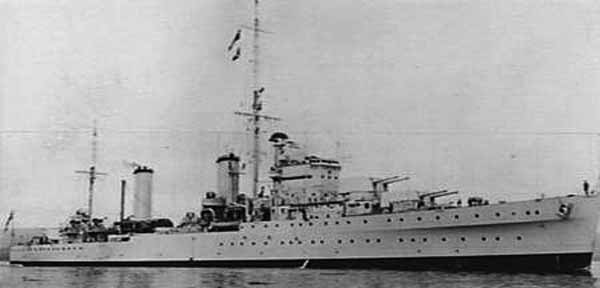
HMS Galatea before the war (AWM)
AA Armament
AA was limited at first, ranging from secondary single mounts (105 mm on Arethusa and Galatea) to twin mounts on Galatea and Penelope. Subsequently Galatea was rearmed in 1940 with 2 quadruple bofors 40 mm (2pdr Mk.VIII), a type 284 radar and an aerial surveillance antenna type 280. In August 1941, it was added four 20 mm Orerlikon, and modifications similar were undertaken on Galatea and Arethusa. The lighter AA armament consisted of eight 0.5-inch Vickers machine guns in two quadruple mountings.
Torpedo Armament
Triple 21-inch (530 mm) torpedo tubes were carried abreast the after funnel in two triple banks with reloads. The beam resulted in cutting one from the bank, contrary to the Leanders which had quadruple banks.
Onboard Aviation
A rotating catapult for a floatplane and a derrick were fitted between the funnels originally. It had been intended to carry a second aircraft aft, but in the end this never happened. HMS Aurora was completed without aircraft facilities, but a deckhouse for Commodore accommodations instead. These four ships had a catapult with a Fairey Fox or a Hawker Osprey, but it was deleted so as not free space and weight for the addition of AA and because of the use of more efficient radars. At the end of the war, the addition of various equipment represented nearly 700 tons. Their hull was considered very satisfactory despite their record and was taken over for the construction of the Dido.
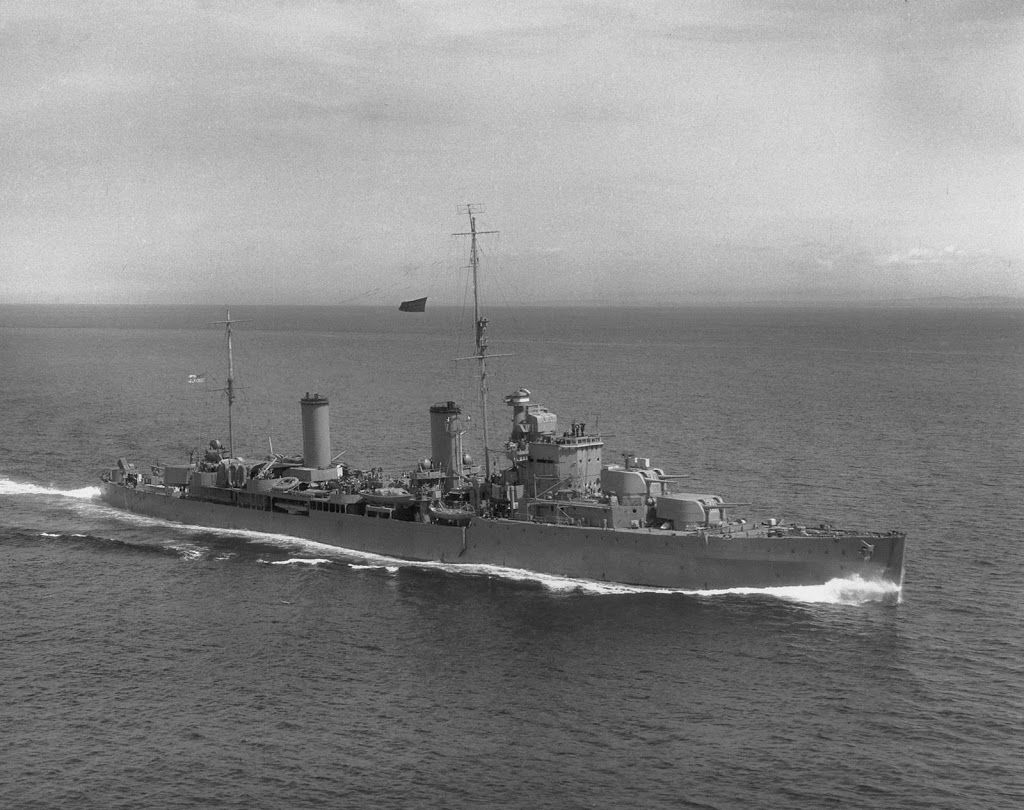
Arethusa at an unknown date
Machinery
As They were a smaller version of the Amphion class, the same machinery layout and two funnels, space was however scarcier overall. The powerpant comprised the same four Parsons geared steam turbines, connected to four propellers shafts, fed by four Admiralty 3-drum boilers. In total it produced around 64,000 shp (48,000 kW), for a top speed of 32.25 knots (59.73 km/h) and a range of 5,300 nmi (9,800 km; 6,100 mi) at 13 knots (24 km/h) with an oil supply of 1,325 tons.

An author’s HD Illustration of the Arethusa

HMS Aurora with Force H in 1942, Operation Torch (more to come)
HMS Arethusa 1939 specifications |
|
| Dimensions | 154 m x 16 m x 5 m draught (full load). |
| Displacement | 5,520 t. standard -6,600 t. Fully Loaded |
| Crew | 500 |
| Propulsion | 4 shafts Parsons turbines, 4 Admiralty boilers, 64,000 hp. |
| Speed | 32.2 knots, Range 5,300 nautical at 13 knots. |
| Armament | 3×2 6-in (152 mm), 4×2 102 mm MK VIII AA, 1×4 40 mm AA, 4×4 x 0.5 Vickers AA, 2×3 21-in TTs. |
| Armor | Belt 60 mm, turrets 60 mm, ammunition magazines and citadel 90 mm. |
Career of the Arethusa class
The four ships served until the middle of the year, and had a busy career. The Galatea was sunk in December 1941 by U-557 in front of Alexandria, and HMS Penelope in front of Anzio in February 1944 (by U-410). The other two survived the war. Arethusa was scrapped in 1950, and the Aurora was transferred to Nationalist China in 1950 and renamed Chungking, was captured by the Communists, and served under several names before being scrapped in the sixties.

HMS Arethusa in 1940 (Author’s old ilustration)
HMS Arethusa

Arethusa in April 1942 – AWM
HMS Arethusa was assigned to the 3rd Cruiser Squadron, Mediterranean, and still served there when World War II broke out. In 1940 she and Penelope were transferred to the Home Fleet at the newly created 2nd Cruiser Squadron with their two other sister-ships. Arethusa participated in the Norwegian Campaign in April 1940, and by May the Nore Command, fighting off in Calais and assisting forces at Dunkirk and later French Atlantic ports. On 28 June 1940 she she joined the newly created Force “H” at Gibraltar. Her first action was against Vichy French forces at Mers el Kebir in July 1940, and she took part afterwards in convoy duties in the Atlantic always based at Gibraltar.
When the Bismarck was out in May 1941 she was stationed in Iceland and patrolled the Faroes Islands, but did no took part in the finaloperations against the battleship. She soon went back to the Mediterranean, escorting Malta convoys and carrying goods and materials. Back in home waters she took part in the Lofoten raid in December 1941, damaged by near-misses. After repairs in Chatham until April 1942 she serve in the Med until June 1942, 15th Cruiser Squadron protecting convoys to Malta.
During Operation Stoneage, she was it by an Italian airborne torpedo on 18 November 1942. She was repaired Alexandria until 7 February 1943, and at Charleston Navy Yard, until 15 December 1943. She was however only operational again in June 1944 with mny revision of armament, radars and other modifications. Part of Force “D” off Sword Beach she covered the landings in June 1944. She also carried later King George VI to Normandy, toureing the beaches Allied headquarters. In January 1945, Arethusa was back in the Med, part of the 15th Cruiser Squadron, until October 1945. She was place din reserve at the Nore. After a failed sale to the Royal Norwegian Navy in 1946 she was used for trials and experiments by the RN in 1949, and on 9 May 1950, she was broken up.
HMS Aurora

HMS Aurora in 1938
HMS Aurora first service with with the Home Fleet but in September 1939 she was stationed with the 2nd Cruiser Squadron, participating in the campaign of Norway, and searching for the Scharnhorst and Gneisenau. By October 1940 she was under Captain William Gladstone Agnew. In May 1941 she participated in the hunt for the German battleship Bismarck. On 3 June she teamed with HMS Kenya, intercepting the German supply ship Belchen. Until August 1941, she joined Force K, Home Fleet, taking part in operations at Spitzbergen and Bear Island, called Operation Gauntlet. Together with HMS Nigeria, she intercepted a German troop convoy off Norway. During this episode sh sank the KMS Bremse. She was later sne to the Mediterranean, Malta, arriving on 21 October 194, Force K.
By 9 November 1941 she was the leading ship with her sister ship HMS Penelope and the destroyer HMS Lance and HMS Lively. Together they catch and sank most of the Beta Convoy, a battle which saw the escorting Italian destroyer Fulmine sank, Grecale and Euro badly damaged, and the loss of the German transports Duisburg and San Marco, the Italian transports ships Maria, Sagitta and Rina Corrado, Conte di Misurata and Minatitlan.
On 24 November, the same squadron intercepted another Axis convoy, 100 nautical miles west of Crete bound to Benghazi. Maritza and Procida were both sunk by HMS Penelope and HMS Lively, not disturbed by a agressive defense of the Italian torpedo boats Lupo and Cassiopea. By 1 December 1941, HMS Penelope and the destroyer Lively attacked the Mantovani Convoy, sinking the Italian destroyer Alvise Da Mosto and a cargo, Mantovani. HMS Aurora was also at the thick of action in the First Battle of Sirte, 17 December 1941. However her luck turned when on 19 December she ran into a minefield off Tripoli, hit a mine and retired heavily damaged to Malta.
After temporary repairs, then long repairs home an an overhaul, she was back her return to the Mediterranean, Force H in November 1942. She took part in Task Force Center, Operation Torch. At Oran she duelled with Vichy French destroyers Tramontane and Tornade, 8 November 1942. Tornade was sank, while the oher was so badly damaged her captain made her beached to avoid sinking. The following day, she also sank the Vichy-French destroyer Épervier. In December 1942 she was part of Force Q off Bône, trying to catch Axis evacuation and supply convoys running between Trapani and Tunis.
HMS Penelope joined the 15th Cruiser Squadron in 1943, and participated in the Invasion of Sicily and Salerno landings (Operation Avalanche). She was later sent to the Aegean by October 1943. While an escort mission in and out Leros Island on 30 October she was attacked by Ju-87 Stukas and Ju-88 dive bombers off Castellorizo. A 500 kg bomb hit abaft the after funnel, which killed 47 crew and badly damaged exhausts and boilers, crippling her powerplant. HMS Aurora limped back to Taranto for long repairs, until April 1944. By August 1944 she covered the landings in southern France, Operation Anvil Dragoon. Back to the Aegean, she participated in the liberation of Athens. The war ended and she was placed in reserve, for a well-deserved retirement.
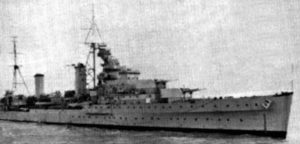 A new life in Chinese service: Chung King
A new life in Chinese service: Chung King
She was sold on 19 May 1948 to the Chinese Nationalist Government as compensation for custom patrol ships and a cargo seized previously by the British in Hong Kong. Renamed Chung King (after the Chinese war time capital Chongqing) she naturally became the flagship of a much depleted Chinese navy after all these war years. By 25 February 1949 however her crew defected to the Communists, where her named was romanised into Tchoung King. By March 1949 however as the Chinese civil war was about to end, she was sunk in Taku harbour by Nationalist aviation, later salvaged but stripped bare to pay for the operations made by the Soviets. The hulk became an accommodation and warehouse ship, renamed Huang He. By 1959 she was transferred to Shanghai and converted as a salvage ship but the conversion project proved too costly and was cancelled. She was sent to Tianjin by June 1965, became a barrack ship under the name Beijing and was still in service, remarkably, by the 1990s before being scrapped. The hull at that time was 60 years old.
HMS Galatea

HMS Galatea in 1939
HMS Galatea first active duty was with the Mediterranean Fleet until September 1938, as flagship, Rear Admiral for the Destroyers quadron based in Malta. She made neutrality patrols during the Spanish Civil War, enforcing the non-intervention policy. In these missions she also collaborated with the pocket battleship KMS Deutschland and Italian destroyers. In Alexandria, she also kept a watchful eye on the Italian invasion of Abissynia. By spring and summer 1938 she was sent in Devonport for retitting. Back in the Mediterranean, she served at Malta and Alexandria. By 29 March 1939 she recovered and carried the leader of the National Defence Council colonel Segismundo Casado and crew later transferred to the hospital ship Maine.
back home after the war broke out, until March 1940 she patrolled to intercept Axis blockade runners from Vigo. From April she particoated in the Norwegian Campaign, until 25 April whe she carried back a part of the Norwegian National Treasury to safety. She was later in the Nore Command as Flagship of the 2nd Cruiser Squadron, by May 1940. The next month, Polish destroyers reached Rosyth and teamed up with HMS Galatea, Arethusa and three destroyers for a patrol in the North Sea, trying to catch German convoys heading for Norway.
At Åndalsnes by late April, HMS Galatea carried troops for the norwegian campaign, going back to Rosyth with other parts of the norwegian national treasury.
By June 1940 she took part in Operation Ariel, one of these little known troops evacuation following Dunkirk, this time from Saint-Jean-de-Luz. This included Sir Ronald Hugh Campbell, the British Ambassador to France.
By September, 7, 1940, there was an alert (Code Cromwell) of a possible secret German operation in Kent at dawn. Galatea patrolled the Straits of Dover but foind nothing, however hitting a mine while returning to port off Sheerness. After three months of repairs she she was back in service by January 1941. By May 1941 she participated in the hunt for KMS Bismarck. In July, she departed for the Mediterranean and in November joined Malta’s Force “K”. Here started like her sister ship Penelope, a long successions of missions against axis convoys in the area. However they were cut short as on 15 December 1941, just before midnight, HMS Galatea under Captain E.W.B. Sim was spotted, approched, torpedoed and sunk by the German U-Boat U-557 off Alexandria. The ship capsize and sank very quickly leaving no chance to 22 officers (including the captain) and 447 sailors, as only 100 survived, to be rescued later by the destroyers Griffin and Hotspur. However the cruiser was avenged 48 hours later, as the German U-boat was rammed and sank by the Italian torpedo boat Orione.
HMS Penelope

HMS Penelope at Spithead in December 1942 – IWM
When World War II started, HMS Penelope served with the 3rd Cruiser Squadron in the Mediterranean, based in Malta. HMS Penelope and Arethusa then moved to the 2nd Cruiser Squadron, Home Fleet, Portsmouth, where they started operations from 11 January 1940. By 3 February, Penelope left for Rosyth where she arrived on 7 February to operate convoy escort missions, and In April to May 1940, particpated in the Norwegian Campaign.
Howevr on 11 April she ran aground off Fleinvær, her boiler room flooded. The destroyer Eskimo towed her to Skjelfjord. Repairs were improvised, patching of her hull’s hole. This proceeded under Luffwaffe air attacks. She was eventually towed home a month later for more repairs at Greenock, Scotland, starting on 16 May 1940. She then sailed on 19 August to the Tyne for definitive repairs, completed in August 1941.
By then, HMS Penelope (Captain A. D. Nicholl) has been considered as a “new ship from the water line down”, also overhauled and modernized. Back to the 2nd Cruiser Squadron, Scapa Flow, on 17 August 1941 she made several patrol sorties and on 9 September escorted the battleship Duke of York to Rosyth. She also patrolled the Iceland–Faroes passage.
On 6 October 1941 she departed Hvalfjord in Iceland, with HMS King George V and HMS Victorious to attack German shipping between Glom Fjord and the West Fjord in Norway.
Penelope and Aurora were later sent back to the Mediterranea, Force K at Malta from 21 October. On 8 November their first mission was to intercept an Italian convoy of six destroyers and seven merchant ships bound to Libya. The battle of Cape Spartivento took place on 9 November, seeing the destruction of the Italian destroyer Fulmine and all merchant ships.
On 23 November, another mission saw both cruisers engaging and destroyong two more merchant ships, west of Crete. By December 1941, Force K sank the Adriatico, destroyer Alvise da Mosto and tanker Iridio Mantovani. On 19 December off Tripoli however, Penelope struck a mine and joined the local dockyard for repairs. She was back into service in January 1942. She escorted the Glengyle to Alexandria (Operation ME9) on the 5, back on 27 January, with the Breconshire.
She left Malta with 6 destroyers to escort the Breconshire on 13 February 1942 to Alexandria (Operation MG5). On 23 March, she left Malta with HMS Legion (Operation MG1) again with Breconshire, which was this time attacked an hit. Unable to move she was taken in tow by HMS Penelope, and later left at Marsaxlokk harbour.
Axis air attacks however had left Penelope damaged forward and aft by near-misses on 26 March and she was drydocked and repaired, but attacked by other German aircraft, taking many more punishment, so much shrapnel holes that she was nicknamed “HMS Pepperpot”. As these were plugged with long pieces of wood she was nicknamed “HMS Porcupine”. On 8 April she left Malta for a less exposed position, only to be attacked en route, but she arrived in Gibraltar on 10 April 1942.
The damage required several months in drydock for repairs in Gibraltar. Captain Nicholl was visited in hospital as well as the ship by the Duke of York and congratulated by the First Sea Lord. It was decided to send her to the United States. She left Gibraltar on 10 May 1942, and arrived at Navy Yard, New York on 19 May, repaired until September 1942. She sailed to Norfolk, Virginia on 15 September and proceeded via Bermuda to Portsmouth. At Buckingham Palace 21 officers were decorated and the crew received the title “Heroes of Malta”, two DSO, a DSC, two DSM were awarded.
Back in the Med after a passage until January 1943 at Scapa Flow, HMS Penelope arrived at Gibraltar on 22 January, allocated to the 12th Cruiser Squadron under Admiral Sir Andrew Cunningham. She will participate in the the follow-up operations of Operation Torch off North Africa and in June 1943 with the destroyers Paladin and Petard she shelled the Italian island of Pantelleria, received enemy gunfire in return. Penelope was hit but with little damage. On 8 June with HMS Newfoundland she shelled the island again and participated later to Operation Corkscrew, leading to the surrender of the island on 11 June 1943. She also took part in the attack on Lampedusa, reduced and surrendered on 12 June 1943.
On 10 July 1943 she sailed with her sister ship HMS Aurora and two destroyers for a shelling on Catania, a diversion moved of the conquest of Sicily, Operation Husky. Both ships also cut the railway to Taormina and station. On 11 July with the 12th Cruiser Squadron, Force H she covered the northern flank of the assault on Sicily and until the ened of summer, provided additoinal naval gunfire support missions.
By 9 September 1943, HMS Penelope was assigned to Force Q for Operation Avalanche, the landings at Salerno. On 26 September she left it with HMS Aurora and sailed to the Levant to particpate in the reconquest of Kos island and the Dodecanese campaign. By 7 October with HMS Sirius she sank six enemy landing craft, an ammunition ship and an armed trawler off Stampalia. However when running off Scarpanto Straits, south of Rhodes, eighteen Ju 87 “Stuka” of I Gruppe Stukageschwader 3 MEGARA fell on them. Penelope was hit by a bomb, and limped back to Alexandria at 22 knots. After repairs she sailed on 19 November 1943 to Haifa (Palestine).
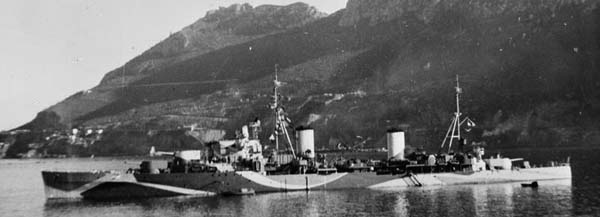
HMS Penelope – IWM
Until the end of 1943, she returned to Gibraltar for Operation Stonewall, trying to intercept blockade-runner in the Atlantic. By 27 December 1943, she participated in the destruction of the Alsterufer. Back to Gibraltar on 30 December she took part in Operation Shingle, the attack on Anzio, with Force X. During these gunfire missions she teamed up with with USS Brooklyn, from 22 January 1944. She also shelled the Formia area and made in total eight cover missions until expending her ammo oout by 8 February.
By February, 18, however, HMS Penelope (Captain G. D. Belben) was sailing out of Naples bound to Anzio when she was spotted, and torpedoed by U-410 (Horst-Arno Fenski). Her after engine room was hit, and sixteen minutes she received another the after boiler room. She sank quickly, carrying with her 417 of the crew and the captain. 206 survived.
Links/sources
Conway’s all the world’s fihting ships 1922-47
https://www.world-war.co.uk/Arethusa/arethusa_class.php3
http://www.navypedia.org/ships/uk/brit_cr_arethusa.htm
https://www.bismarck-class.dk/other_craft_involved/british_ships_involved/cruisers/arethusa.html
https://uboat.net/allies/warships/ship/4009.html
Models Corner
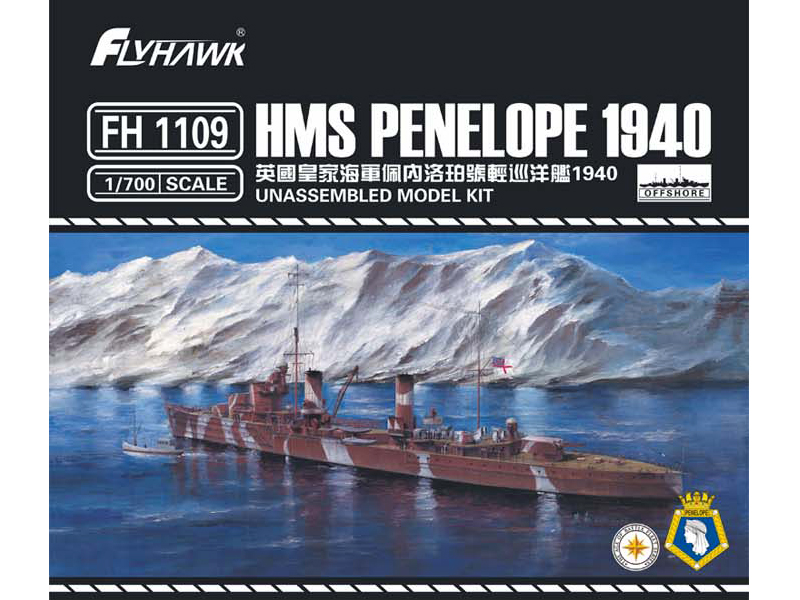
Flyhawk Penelope 1940 1/700 model – The same also made the Galatea in 1939, Aurora in 1945 and Chungking in 1949 (No. FH1111)
More manufacturers
Russian manuf. Modelist made also the Aurora in 1/300 scale, possibly same kist distributed also by Lee
1/96 Plans (CD)
https://klueser.de/kit.php?index=3236&language=en
3D Corner:
https://www.artstation.com/artwork/nNJEO


 Latest Facebook Entry -
Latest Facebook Entry -  X(Tweeter) Naval Encyclopedia's deck archive
X(Tweeter) Naval Encyclopedia's deck archive Instagram (@navalencyc)
Instagram (@navalencyc)





 French Navy
French Navy Royal Navy
Royal Navy Russian Navy
Russian Navy Armada Espanola
Armada Espanola Austrian Navy
Austrian Navy K.u.K. Kriegsmarine
K.u.K. Kriegsmarine Dansk Marine
Dansk Marine Nautiko Hellenon
Nautiko Hellenon Koninklije Marine 1870
Koninklije Marine 1870 Marinha do Brasil
Marinha do Brasil Osmanlı Donanması
Osmanlı Donanması Marina Do Peru
Marina Do Peru Marinha do Portugal
Marinha do Portugal Regia Marina 1870
Regia Marina 1870 Nihhon Kaigun 1870
Nihhon Kaigun 1870 Preußische Marine 1870
Preußische Marine 1870 Russkiy Flot 1870
Russkiy Flot 1870 Svenska marinen
Svenska marinen Søværnet
Søværnet Union Navy
Union Navy Confederate Navy
Confederate Navy Armada de Argentina
Armada de Argentina Imperial Chinese Navy
Imperial Chinese Navy Marinha do Portugal
Marinha do Portugal Mexico
Mexico Kaiserliche Marine
Kaiserliche Marine 1898 US Navy
1898 US Navy Sovietskiy Flot
Sovietskiy Flot Royal Canadian Navy
Royal Canadian Navy Royal Australian Navy
Royal Australian Navy RNZN Fleet
RNZN Fleet Chinese Navy 1937
Chinese Navy 1937 Kriegsmarine
Kriegsmarine Chilean Navy
Chilean Navy Danish Navy
Danish Navy Finnish Navy
Finnish Navy Hellenic Navy
Hellenic Navy Polish Navy
Polish Navy Romanian Navy
Romanian Navy Turkish Navy
Turkish Navy Royal Yugoslav Navy
Royal Yugoslav Navy Royal Thai Navy
Royal Thai Navy Minor Navies
Minor Navies Albania
Albania Austria
Austria Belgium
Belgium Columbia
Columbia Costa Rica
Costa Rica Cuba
Cuba Czechoslovakia
Czechoslovakia Dominican Republic
Dominican Republic Haiti
Haiti Hungary
Hungary Honduras
Honduras Estonia
Estonia Iceland
Iceland Eire
Eire Equador
Equador Iran
Iran Iraq
Iraq Latvia
Latvia Liberia
Liberia Lithuania
Lithuania Mandchukuo
Mandchukuo Morocco
Morocco Nicaragua
Nicaragua Persia
Persia San Salvador
San Salvador Sarawak
Sarawak Uruguay
Uruguay Venezuela
Venezuela Zanzibar
Zanzibar Warsaw Pact Navies
Warsaw Pact Navies Bulgaria
Bulgaria Hungary
Hungary

 Bundesmarine
Bundesmarine Dutch Navy
Dutch Navy Hellenic Navy
Hellenic Navy Marina Militare
Marina Militare Yugoslav Navy
Yugoslav Navy Chinese Navy
Chinese Navy Indian Navy
Indian Navy Indonesian Navy
Indonesian Navy JMSDF
JMSDF North Korean Navy
North Korean Navy Pakistani Navy
Pakistani Navy Philippines Navy
Philippines Navy ROKN
ROKN Rep. of Singapore Navy
Rep. of Singapore Navy Taiwanese Navy
Taiwanese Navy IDF Navy
IDF Navy Saudi Navy
Saudi Navy Royal New Zealand Navy
Royal New Zealand Navy Egyptian Navy
Egyptian Navy South African Navy
South African Navy






























 Ukrainian Navy
Ukrainian Navy dbodesign
dbodesign